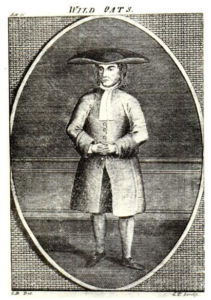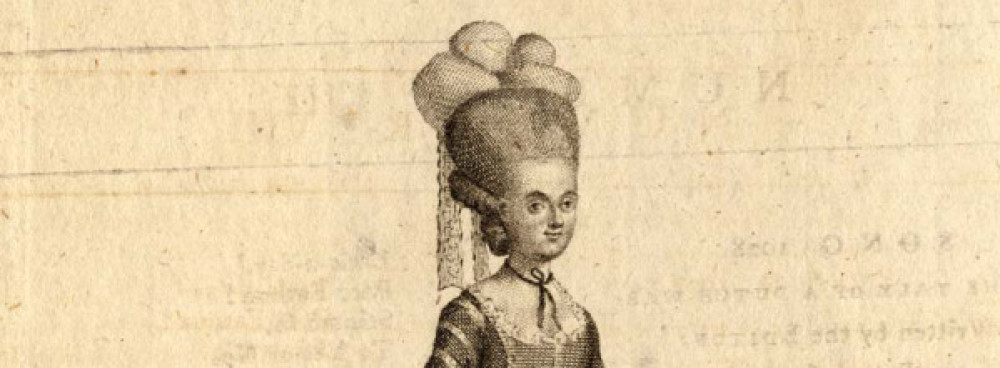Maria Henry was known to her audiences as the “first prima donna” on the American Stage.[i] A talented actress as well as singer, Maria Storer married John Henry, a manager of the Old American Company sometime between 1785-1788. According to A Biographical Dictionary of Actors, Actresses, Musicians, Dancers, Managers & Other Stage Personnel in London, 1660-1800 she “possessed also all of the most desirable singing roles” and it was up until the arrival of Mrs. Pownall in 1792 that she was considered the best singer in the company.[ii] A comedian by trade, “Dunlap called her a small, fair woman whose figure gave no aid in tragedy. Her judgment, however, made her effective in everything,”[iii] showing that she was able to execute a justified performance in both comedy and tragedy, no matter her size.

John Henry
Before achieving public approval and fame, Mrs. Henry was a Miss Maria Storer, the youngest of the four Storer sisters. The first two sisters were John Henry’s first wives previous to his marriage to Maria:
“As every student of our stage-history knows, there were four Miss Storers, three of whom were, in succession, attached to John Henry. The first of these, actually Mrs. Henry, lost her life, we are told, in a fire at sea between Jamaica and this country, and was never seen here; the second was Ann or Nancy Storer, who became by Henry the mother of a child; toward the end of the century she was popular as an actress under the name of Mrs. Hogg. The youngest of the girls–Maria–was a mere child in 1767-68, appearing only in parts such as one of Antony’s children in All for Love, and singing between the acts at benefits. Later, as Mrs. Henry, she was a successful singer and a good actress in comedy and tragedy. The third Miss Storer—Fanny—was the only one to escape being Mrs. Henry,”[iv]
Maria Henry would later be known as one of the top-notch comedians of the Old American Company, even following her death. Yet, even with talent abound, Mrs. Henry faced both criticism from the public as well as rivalry with other actresses in the company. It appears evident that public criticism was well validated and that “Mrs. Henry, by her increasing arrogance, had been particularly a storm-centre; newspapers had argued for and against, and audience had, on occasion, been unruly.”[v] The public’s disdain stemmed from her habits of sporadic and fragmented withdrawal from parts considered beneath her: “The criticisms were especially strong against Maria Henry, admittedly excellent in singing roles and a great favorite when she wished to be, but capricious and disdainful of her public, then refusing to appear or playing negligently in minor parts.”[vi] This bad press, combined with an apparent inclination to illness (whether true or not), and a dependence on alcohol, aided in her future withdrawal from the stage.
It is agreed upon through both first and second-hand accounts that Maria Henry tended to abuse alcohol, which only grew as she moved towards the end of her career. It is noted in Durham’s American Theatre Companies, 1749-1887 that “Internal strife grew as Maria Storer Henry’s incontinent use of alcohol created embarrassment behind the scenes and on stages.”[vii] This became increasingly problematic for the theatre as audience members witnessed her spiraling career from beloved actress to despised drunkard: “John Durang wrote: “I have seen Mrs. Henry set in a chair in front of the stage crying thro’ passion while the orchestra play’d her music through of a song in an opera. The performers at the same time concealing themselves behind the wings.”[viii]
On the other hand, Mrs. Henry remained enchanting to audience members at times, whether she was on the stage or not. One such account of note was that of W.B. Wood in his Personal Recollections of the Stage when he writes: “Mr. and Mrs. Henry were the first performers who ever made a lasting impression upon me, particularly the lady, a perfect fairy in person. She usually came full dressed to the theatre in the old family coach; and the fashion of monstrous hoops worn at that day, made it necessary for Mr. Henry to slide her out sideways, take her in his arms, and carry her like an infant to the stage entrance.”[ix] No matter her dependence on the drink, she remained an enchantress on the stage up until her exit from the stage in the mid-1790s.

John Street Theatre Interior
It was in 1794 that John Henry decided to leave the Old American Company: “weary of the trouble he met with from various sources in the management of the property at that time known and generally styled the old American Company” after which he sold shares to Lewis Hallam, John Hodgkinson, and others.[x] The Henrys retired shortly thereafter to their home behind the theatre in Philadelphia. Following their departure from the stage, John Henry died in October of 1794 at sea on a voyage to Rhode Island:
“Shortly, after his retirement he died on board a vessel bound for Rhode Island, and, according to Dunlap, was “buried without ceremony under the sand of an island in the sound.” [xi]
Maria followed closely behind her husband into the grave, and died, it is reported, the following April:
“His wife, who was with him, it is supposed never recovered from the shock, and died, deprived of reason, at Philadelphia, 25th April, 1795, after having had the dead body of her husband brought to her, from its first place of unceremonious interment.”[xii]
The whereabouts of her grave are undetermined and the few records available do not indicate where her body was interred.
NOTES
[i] Philip H. Highfill, Kalman A. Burnim, and Edward A. Langhans. A Biographical Dictionary of Actors, Actresses, Musicians, Dancers, Managers & Other Stage Personnel in London, 1660-1800.Carbondale: Southern Illinois University Press, 1973. 274. Print.
[ii] Highfill, 274.
[iii] Highfill, 274.
[iv] George Clinton O’dell Densmore, and Princeton University. Annals of the New York Stage. New York: Columbia University Press, 1927. 120. Print.
[v] O’Dell, 91-92.
[vi] Pollock, 49.
[vii] Weldon B. Durham. American Theatre Companies, 1749-1887. New York: Greenwood Press, 1986. 15. Print.
[viii] Highfill, 274.
[ix] William B Wood. Personal Recollections of the Stage: Embracing Notices of Actors, Authors, and Auditors, During a Period of Forty Years. Philadelphia: H.C. Baird, 1885. 25. Print.
[x] William Dunlap, and Tice L. Miller. A History of the American Theatre from Its Origins to 1832.Urbana: University of Illinois Press, 2005. 115-116. Web.
[xi] Glenn Hughes. A History of the American Theatre, 1700-1950.New York: S. French, 1951. 69. Print.
[xii] Hughes, 69.
By: Drew Smith
